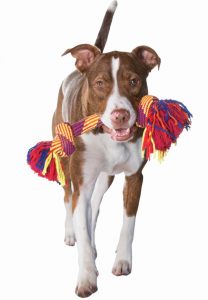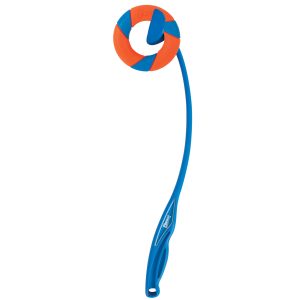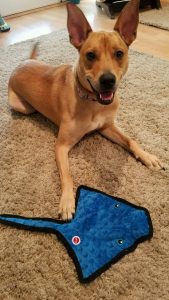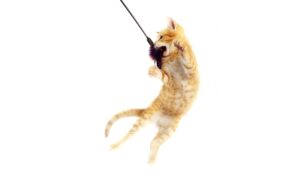The Evolution of the Pet Toy
Alexandra Wepner //September 13, 2018//
It was the perfect storm of economic development and shifts in cultural attitudes regarding animals that resulted in the kind of pet ownership we’d recognize today. Simply put, your relationship with your favorite furball is the result of a series of human decisions made throughout tens of thousands of years in history.
According to Gregor Larson, director of the University of Oxford Paleogenomics and Bio-Archeology Research Network, it’s difficult to pinpoint exactly when the concept of the “pet” emerged. Quoted by Alicia Ault in “Ask Smithsonian: When Did People Start Keeping Pets?” (published in September of 2016), Larson explains that “it’s more about how animals have taken on different roles in human society over the centuries.”
To illustrate that point, Ault reports that Larson’s team had published evidence of dog domestication from between 14,000 and 16,000 years ago, and that dogs had been discovered buried with high-value items from as early as 8,000 years ago. According to “The Evolution of Pet Ownership,” published by Pedigree, royalty in Greek, Roman, Chinese and Egyptian societies were known to keep tamed or domesticated animals throughout history.
In the Middle Ages, however, Christian leaders looked unfavorably upon animal companionship, even linking it to pagan worship and deeming such relationships out of the natural order of life. Attitudes toward pet keeping seemed to soften in Europe during the 17th century, and it became more common among middle classes beginning in the late 1700s. In the Victorian Age, humans began to see nature as less threatening and the pet as a link to the natural world and a symbol of man’s dominion over it.
The turn of the century ushered in a new era of pet ownership, and the birth of the modern day pet industry soon followed. In “Playthings, Then and Now”—written for the American Kennel Club in 2008, drawing from Katherine C. Grier’s “Pets in America: A History”—author Roxanne Hawn marks this period as a turning point.
“Dogs as companions and a form of leisure gained strength as we moved from a rural to an urban culture,” Hawn writes. “Incomes grew. Store-bought product multiplied as manufacturing improved, and marketing efforts built excitement.”
According to “Companion Birds in Early America” by Christal G. Pollock, DVM, Dipl ABVP (Avian), birds were the most popular indoor pets in the United States by the 19th and  20th centuries across classes and races. Pollock writes that “like televisions and radios of present day, birds brought beautiful song and a cheerful level of noise that was welcome in quiet, early American homes.”
20th centuries across classes and races. Pollock writes that “like televisions and radios of present day, birds brought beautiful song and a cheerful level of noise that was welcome in quiet, early American homes.”
“The pet industry began with bird stores in the 1840s,” according to Hawn. “By the 1890s, pet stores opened in major cities, with broader merchandise of both live animals and the accoutrement to care for them.”
According to Grier, toys were relatively rare for humans until the late 19th century—never mind toys for pets. But soon, an entirely new kind of consumer had emerged: one driven by emotion rather than necessity alone. Starting in the 1920s, department stores opened pet sections. The pet toy market, though, was still in its infancy.
“While a few industrious people or companies sewed leather balls for sale as dog toys, items we’d recognize did not hit the market until the 1950s, following technological and societal advancements after World War II,” Hawn writes, citing better rubber, manufacturing and higher incomes as key developments.
Revisiting the Classics
A seminal period for pet toy design, the 1950s saw the introduction of rawhide chews and artificial bones. Nylabone entered the market in 1955, and the company has since expanded to offer lines of edible chew treats, non-edible chew toys, interactive toys and dental solutions for dogs of a range of sizes and chew strengths.
Next to a bone or a ball, perhaps the most popular dog toy in the early- to mid-20th century was the rope. Though Mammoth Pet Products began making dog toys in the ’80s and ’90s, the classic rope is still a prominent part of the brand’s offerings. Of course, they’ve evolved quite significantly since those early designs.
“Products are designed for pet interaction, fun, durability, value, sustainability and safety,” said Charles Byrne, president of the company. “[The toys have evolved from] simple
1980s and ’90s rope designs to more complicated designs using a wider variety of advanced raw materials and processes… For example, Mammoth now offers a Flossy Chew EXTRA rope line specifically developed for strong-chewing dogs.”
The Flossy Chews EXTRA Fresh line uses beeswax and real floss material to floss dogs’ teeth while they chew. Mammoth also makes a range of braided and tied rope-inspired toys, including several in imaginative shapes (snake and iguana), and with squeak and tennis ball components.
However, Hawn credits KONG as the true pioneer in the dog toy market. Joe Markham famously invented the toy after realizing how much enjoyment his trained police dog, Fritz, got out of a discarded rubber suspension piece from Markham’s Volkswagen bus. What resulted was a super durable, stuffable dog toy that was easier on teeth than the rocks and sticks that Fritz had previously chewed which sparked a watershed of food-delivery toys with its introduction in 1976. The variety of products in the line was also unprecedented—most dog toys before then were “one size fits all,” Hawn points out.
Next Generation Play
Following the turn of the century, the next big shift in our attitudes toward pets came in the late 1980s and ’90s. For a long time, humans had evolved past the belief that animals existed solely to serve mankind. And now, pet owners were beginning to value a strong connection with their pets and sought to increase the quality of their interactions. By the early 2000s, “interactivity” had become the newest buzzword in pet toy design. Brands looked to physical play and incorporating owners into that playtime as ways to strengthen the human-animal bond.
West Paw, founded in August 1996, makes toys focused on “providing an incredible experience for both the dog and the user,” says Spencer Williams, the compan y’s founder. West Paw is well known for its durable Zogoflex material and its first product, the Hurley. Most recently, the company took a look back at the most iconic pup playthings in history to make them safer and more effective toys.
y’s founder. West Paw is well known for its durable Zogoflex material and its first product, the Hurley. Most recently, the company took a look back at the most iconic pup playthings in history to make them safer and more effective toys.
“When we think about the original dog toys, of course the first thing that comes to mind is the stick,” Williams said. “Sticks are not safe—they can splinter in the mouth, puncture the back of the throat and cause serious damage, and yet dogs love the fact that they can carry it in their mouth.”
As an improvement, West Paw released the Zwig (a play on the word “twig”): an elongated chew toy made of soft yet durable Zogoflex material, which is also buoyant and can be thrown. The Zwig’s launchmate, the Rando, is an improvement on the time-tested tennis ball. It’s hollow, buoyant and has a random bounce, designed to re-engage a dog’s hunting skills when owners throw the toy. It’s free of toxic glues found in tennis balls and has an extra layer to avoid waring down dogs’ enamel.
Based in Wichita, Kansas, Hyper Pet was originally founded as a manufacturing company for small animal and equine products but now specializes in dog toys that encourage an active lifestyle. The K-9 Kannon, HyperDog Ball Launcher and Flippy Flopper Flying Disc are a few of Hyper Pet’s award-winning dog toys. An offshoot of the Hyper Pet brand, PETLOGIX services the independent pet specialty channel specifically.
“PETLOGIX is our new pet product brand with a commitment to changing a family’s relationship with their pet through innovative products that promote a healthy, safe and interactive lifestyle,” the company states on its website. “The brand’s dog toys encourage both mental and physical enrichment and provide a happy, bonding playtime experience for pets and their owners.”
By the mid-aughts, Petmate had acquired one of its most iconic toys: the Chuckit! Since its invention 20 years ago, the Chuckit! has spawned a number of additional products, such as the Junior Launcher, the Indoor Roller, the Rebounce Ball and the Flying Squirrel.
“For the Chuckit!, it’s that core premise of interacting with your dog— playing and bonding with your dog,” said Chris Wilson, executive vice president of Marketing and Development at Petmate. “And even as much as we love our pets, picking up that slobbery tennis ball is never a really pleasant thing. So, you can pick it up with the launcher and you can throw it further so they get better exercise.”
And though it’s clear that pet owners value healthy outdoor playtime, everyone has to go home at some point. Chew toys, often plush, are a popular choice for indoor play, and durability has remained a top concern for pet consumers.
Grown from the “seeds,” of the pet industry, Ethical Products was founded in 1952 by Alan Zelinger as a manufacturer of primarily bird seed, cages and toys, though the company now makes dog and cat toys. One of Ethical Products’ most innovative contributions to the pet toy market was Skinneeez, introduced in 2008.
“We noticed that one of the biggest problems consumers had with traditional stuffed dog toys was the ability of many dogs to immediately rip out the stuffing, thus rendering the toy useless,” said Jonathan Zelinger, president of Ethical Products. “To rectify this problem, we eliminated the stuffing, which has resulted in a more durable play toy for dogs.”
Mind and Body
Since the birth of KONG, treats and toys had been an effective team in keeping pets entertained for hours on end. However, pet owners of the new millennium realized the health benefits of challenging pets mentally as well as physically.
Enter the puzzle toy. While some of today’s puzzle toys are direct descendants of the simple, stuffable rubber toys of yesteryear, the category runs the gamut in terms of complexity.
For example, the Busy Buddy Barnacle from PetSafe is bouncy, with multiple chambers for treats. The Busy Buddy Magic Mushroom is a bit more of a challenge, as dogs spin and roll the contraption in an effort to release hidden treats or kibble. Owners can adjust the toy’s windows to change the level of difficulty. Other puzzle toys include Kruuse’s BUSTER Activity Mat and Outward Hound’s Hide-a-Squirrel plush puzzle toy (which actually works without treats).
Of course, toys that give pets a cognitive workout can be found for species besides dog.
For instance, Kaytee’s Toss & Learn Carrot Game encourages small animals to keep active as they discover treats owners can hide under wooden carrot chew toys. The Mini Nut Knot Nibbler motivates small animals to gnaw and chew at the natural wood construct to reach a treat trapped in its center. For pet birds, there’s the Desktop Activity Center that actually aims to strengthen the human-pet bond. Parakeets and cockatiels can enjoy playtime in the toy’s space-saving tabletop unit that holds seven interactive toys and adjustable perches for keeping playtime fresh.
And in fact, the cat category presents an interesting case in the evolution of pet toys.
As the advent of puzzle toys added a new layer of complexity to pet toy design, the next logical evolutionary step might be electronic toys—and many pet brands already have electronic toys for cats, or at least toys with electronic components. For instance, Petmate has the Jackson Galaxy Galaxy Spiral with LED balls that light up when swatted by playing cats. PetSafe offers the Zoom Rotating Laser Cat Toy or the Flik Automatic Teaser Cat Toy, among several other electronic toys.
“I think there is a cautious yet enthusiastic desire to bring technology into the pet industry in general, but ‘play’ is one of the categories that people are most excited about,” said Wilson, of Petmate.
R2P Pet, which makes toys for both dogs and cats, has placed a particular focus on developing more cat wares in the recent year. Rita Zine-Himy, vice president of Product Development for the company, links the evolution of interactive toys to electronic toys, which enhance playtime bonding and keep pets engaging in regular, healthy playtime even if their increasingly busy pet parents can’t participate. Under the Categories brand, R2P offers the Flutter Flyer, the Zany Cat Ball and the Puff Squeak, to name just a few in its “Electronic” segment.
“Interactive cat toys had always been limited to wands and other basic toys,” she said. “We wanted to offer more options that kept cats active and their parents happy. This is a huge area of opportunity: cat parents are searching for new, and more innovative, electronic toys that help exercise the mind and body.”
Looking forward, Zine-Himy believes this trend will only continue.
“Innovation is going to continue to be the focus,” Zine-Himy added. “New materials, technology and electronic options, and a focus on toys that truly benefit our pets will all help drive the next generation of pet toys.”
Play, but with Purpose
In the American Pet Products Association’s 2017-2018 National Pet Owners Survey, it was revealed that the country’s pet-owning population is becoming increasingly youthful. For the first time, millennials beat out all other generations to become the largest segment of pet owners across all species, including dogs, cats, birds, small animals, reptiles, fish and horses. The pet consumer pool itself is changing, and that will affect tomorrow’s pet toys (and any other pet product, for that matter) and the companies that make them.
In 2017, Forbes published Sarah Landrum’s “Millennials Driving Brands to Practice Socially Responsible Marketing.” In it, Landrum examines the ways in which millennials are changing the rules of engagement when it comes to how businesses persuade consumers to spend their money.
“Millennials, on average, are most riskaverse and are less likely to spend money unnecessarily than previous generations,” Landrum wrote. “But when millennials do decide to part with their money… [they] prefer to do business with corporations and brands with pro-social messages, sustainable manufacturing methods and ethical businesses standards.”
And as millennials assume a larger share of dollars spent in the pet market, their consumer demands are affecting the way pet products are designed and marketed—pet toys included.
“People are just more aware of everything,” said Jill Connolly, new product development manager for RC Pet. “They want the whole story.”
In 2016, the company launched RC Pet Toys, handcrafted with wool from Nepal. According to the brand’s website, “each purchase connects [pet owners] to a much greater cause: helping Nepalese women to earn a living and support their families and their future.”
Connolly points out that wool is an all-natural, antifungal, washable and durable material. RC Pet Toys bills the collection as “fun, sustainable, good for your pet and good for our planet.”
“To be able to be helping a community as well made it an even easier decision for us,” Connolly said. “If we were going to enter [the pet toy market], we wanted it to be true to who we are and a product that we felt very strongly about and that we’re proud to represent.”
Of all the ways brands could demonstrate social responsibility, investing in sustainability and “green” business practices seems to be one of the most popular. As climate change becomes a prominent topic in public discourse, some companies are beginning to reexamine their supply chains and adopt energy- and waste- saving measures. Others, like Planet Dog, were ahead of the sustainability curve.
“Sustainability permeates our values, our product development and our social commitment, leading us to become a founding member of the Pet Sustainability Coalition, an industry-wide collaboration to provide tools and education to accelerate environmental and social sustainability,” the brand states on its website.
Most Planet Dog products are made in the USA with its proprietary Orbee-tuff material. The Orbee-tuff RecycleTOYS line, which includes Recycle Balls and Bones, was designed to capture and re-use 100 percent of the excess material the company says is inherent to the injection molding process.
Recently celebrating its 25th anniversary, Greenfeather Bird Supply is known for its handcrafted toys for birds and small animals. Dena Tucker, owner, says the company is the first bird and small animal toy manufacturer to be a Green America Certified Business.
It’s apparent that pet owners across species want more out of the toys they give their animals. According to Tucker, people are no longer satisfied with tossing a paper towel roll into a small animal’s habitat—and in fact, these items are now known to be unhealthy for critters.
“Over time I have seen an evolution of available materials for creating Greenfeather Bird Supply toys, giving me the ability to make more conscious choices in the companies and the products used to ensure the quality of GFB toy parts and raw materials,” Tucker said, labeling the toys sustainable, recyclable, compostable, up-cycled, fair-trade, non-toxic, organic, locally harvested and made in the USA.
And while that list might seem a bit excessive to an outsider, anyone in the pet industry would know it’s the reality of what today’s pet shoppers demand, and sometimes even expect. Sure, toys should be fun, above all else. But it’s really not that simple anymore.
We’ve come a long way—and it all only took about 20,000 years.



















